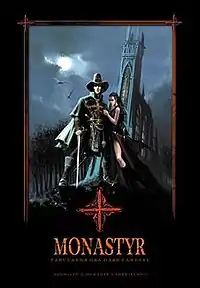Monastyr
Monastyr is a Polish role-playing game published in 2004.[1] It is set in a dark fantasy world of Dominium. Its setting features a fantastic equivalent of the Age of Enlightenment. Most often, the game plays in a cloak and dagger mood and involves plotting, intrigue, but also struggle in the name of honour. The game has been inspired by such authors as Alexandre Dumas, père, Michael Moorcock and H. P. Lovecraft. It is published by Wydawnictwo Portal (Portal Publishing House) and it is currently available only in Polish.
 Cover of Monastyr hardcover edition | |
| Designer(s) | Ignacy Trzewiczek, Michał Oracz, Marcin Blacha |
|---|---|
| Publisher(s) | Wydawnictwo Portal (Portal Publishing House) |
| Publication date | 2004 |
| Genre(s) | dark fantasy, cloak and dagger, Period Adventure (Age of Enlightenment) |
| System(s) | 3d20 system |
The game does not shy from dealing with serious issues such as religion or race. The players have to play humans, and they are all followers of a certain monotheistic religion, known as Karianizm. The religion is based on Christian faith in one god mixed with reincarnation and the cycle of life known from Hinduism. The human countries, tied together with that religion, are involved in a long struggle against all other races (elves, dwarves, orcs, etc.); their religion dictates that all of those races are doomed and are beyond salvation, therefore must be exterminated as a minions of evil god Kusiciel (from polish Tempter.) Magic is also considered a sign of a devil or demons, so there are no (overt) mage characters.
The corebook, Monastyr, does not describe the lands of non-humans, instead it concentrates on the human empire, which, while united by a single faith and church, and is composed of over fifty separate countries, each involved in various struggles, political or military, with others.
Monastyr mechanics are based around the 3d20 system.
References
- Mochocka, Aleksandra (2017). "Świat i historia – "Monastyr: Fabularna gra dark fantasy"". Narracje fantastyczne (in Polish): 501–517.
External links
- (in Polish) Monastyr's official website